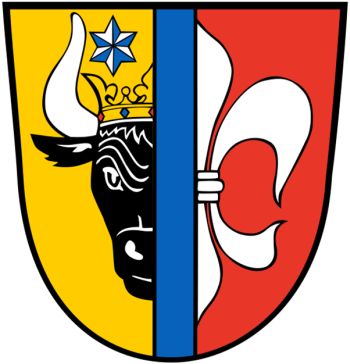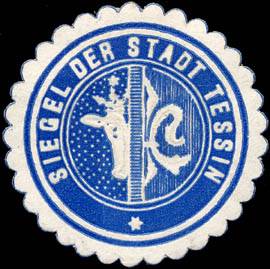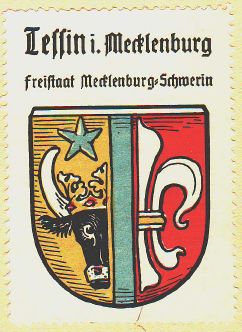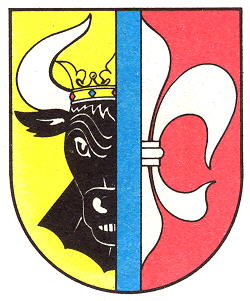Tessin: Difference between revisions
Knorrepoes (talk | contribs) |
Knorrepoes (talk | contribs) |
||
| Line 21: | Line 21: | ||
The arms already are known from the oldest seal of the city from 1364. The only element of which the meaning is clear, is the bull's head of Mecklenburg-Rostock. The pale probably symbolises the Recknitz river, which flows through the city and which was a border river between Mecklenburg and Pommern. | The arms already are known from the oldest seal of the city from 1364. The only element of which the meaning is clear, is the bull's head of Mecklenburg-Rostock. The pale probably symbolises the Recknitz river, which flows through the city and which was a border river between Mecklenburg and Pommern. | ||
The meaning of the fleur-de-lys and the star is not known. Hupp (+/- 1925) showed the arms with a five-pointed star, whereas the arms historically showed a six-pointed star. During DDR times the star was omitted from the arms and the bull's head was shown with the so-called 'neck', which is the more common Mecklenburg bull. However, the Mecklenburg-Rostock dynasty used the bull without the neck. | The meaning of the fleur-de-lys and the star is not known. Hupp (+/- 1925) showed the arms with a five-pointed star, whereas the arms historically showed a six-pointed star. | ||
During DDR times the star was omitted from the arms and the bull's head was shown with the so-called 'neck', which is the more common Mecklenburg bull. However, the Mecklenburg-Rostock dynasty used the bull without the neck. | |||
{|align="center" | {|align="center" | ||
Revision as of 07:04, 6 July 2012
| Heraldry of the World Civic heraldry of Germany - Deutsche Wappen (Gemeindewappen/Kreiswappen) |
TESSIN
State : Mecklenburg-Vorpommern
District (Kreis) : Rostock (until 2012 Bad Doberan)
Amt : Amt Tessin
Official blazon
Gespalten durch einen blauen Pfahl; rechts in Gold ein halber hersehender schwarzer Stierkopf mit silbernen Hörnern, goldener Krone und geschlossenem Maul am Spalt, überhöht von einem blauen sechsstrahligen Stern, links in Rot eine halbe silberne Lilie am Spalt.
Origin/meaning
The arms were officially granted on April 10, 1858.
The arms already are known from the oldest seal of the city from 1364. The only element of which the meaning is clear, is the bull's head of Mecklenburg-Rostock. The pale probably symbolises the Recknitz river, which flows through the city and which was a border river between Mecklenburg and Pommern.
The meaning of the fleur-de-lys and the star is not known. Hupp (+/- 1925) showed the arms with a five-pointed star, whereas the arms historically showed a six-pointed star.
During DDR times the star was omitted from the arms and the bull's head was shown with the so-called 'neck', which is the more common Mecklenburg bull. However, the Mecklenburg-Rostock dynasty used the bull without the neck.
| Seal from around 1900 |
The arms in the Kaffee Hag albums +/- 1925 |
Arms during DDR time (without star) |
Literature : Bensing et al; 1984




